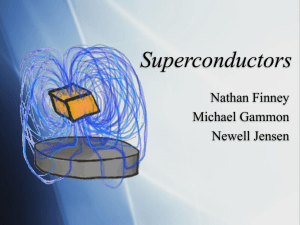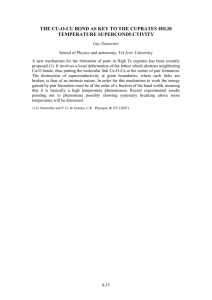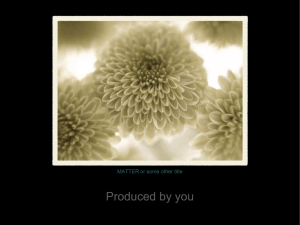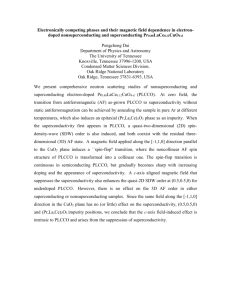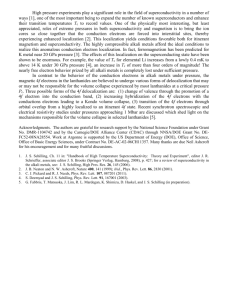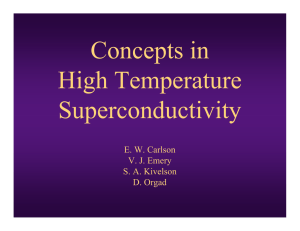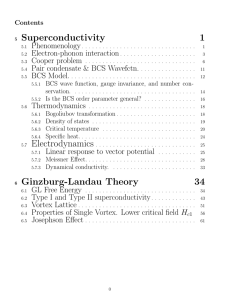Superconductivity
advertisement
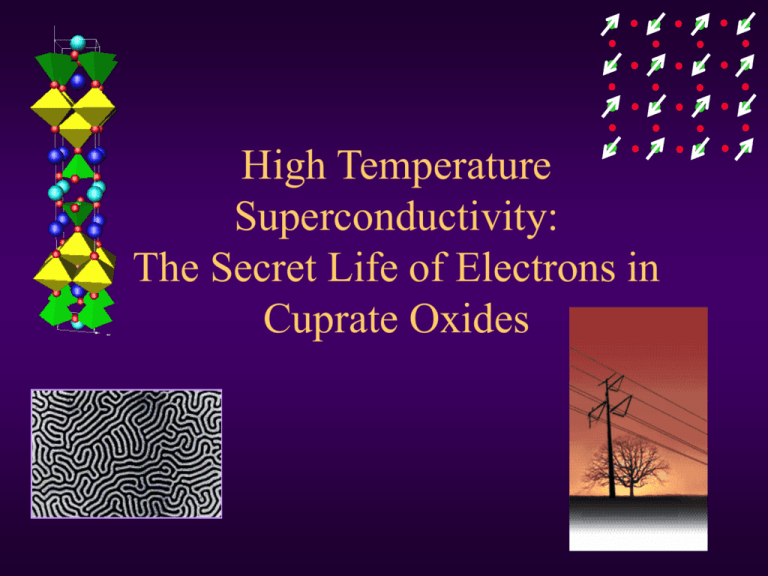
High Temperature Superconductivity: The Secret Life of Electrons in Cuprate Oxides Metals • Shiny • Smooth • Malleable • Carry current (conduct electricity) Metals and Current • V = IR • Resistance • Wires radiate power away as heat • You pay for more electricity than you receive! • Electrons “scatter” off lattice, and lose energy Superconductors http://micro.magnet.fsu.edu • • • • Carry current perfectly Do not lose energy Current in a loop will run forever Expel magnetic fields (Meissner effect) Levitation Levitation How does it happen? Matter No two pieces of matter may occupy the same space at the same time (Only half true) Two kinds of particles Fermions Bosons (spin 1/2, 3/2, 5/2, etc.) (spin 0, 1, 2, etc.) • Cannot occupy the same space at the same time • Pauli exclusion principle Antisocial • Can occupy the same space at the same time All Follow the Crowd Electrons are Fermions Pauli exclusion principle Why most matter cannot occupy the same space at the same time Bosons Can occupy the same space at the same time Photons are bosons lasers Helium is a boson superfluidity Bose condensation • At low temperature, bosons flock to the lowest level • Very stable state! • Dissipationless flow • Superfluidity (Helium) • Superconductivity (metals at low temperature) Superconductivity • • • • Pair electrons form bosons Bosons condense into the lowest orbital Quantum mechanics! Very stable state Dissipationless current flow Conventional Superconductivity Based on an instability of the simple metallic state Superconductors Have Zero Resistance? • Metals: electrons “scatter” off lattice and lose energy resistance • Superconductor: electrons pair • Bosonic electron pairs in lowest state already • There’s no lower state for them to scatter into • Same as why atoms are stable John Bardeen Leon Cooper Bob Schrieffer Conventional Superconductivity • BCS Theory • Instability of the metallic state Cooper Pairing • Electrons in Metal Can Pair via the lattice www.superconductors.org BCS Haiku: Instability Of A Tranquil Fermi Sea— Broken Symmetry And then there was 1986 http://www.eere.energy.gov/superconductivity/pdfs/frontiers.pdf A Ceramic Superconductor? • • • • Brittle Ceramic Not Shiny Not metallic http://www.superconductivecomp.com/ • Why do they conduct at all? High Temperature Superconductors HgCuO YBCO7 LSCO High Temperature Superconductors Copper Oxygen Planes Other Layers Layered structure quasi-2D system High Temperature Superconductors Copper-Oxygen Planes Important “Undoped” is half-filled Antiferromagnet Naive band theory fails Strongly correlated Oxygen Copper High Temperature Superconductors Dope with holes Superconducts at certain dopings T AF Oxygen Copper SC x Mysteries of High Temperature Superconductivity • • • • Ceramic! (Brittle) Not a simple metal Magnetism nearby (antiferromagnetism) Make your own (robust) http://www.ornl.gov/reports/m/ornlm3063r1/pt7.html • BCS inadequate! Two Ingredients for Superconductivity Pairing Condensation Single Particle Gap Superfluid Density BCS is a mean field theory in which pairing precipitates order Material Tpair[K] Tc[K] Pb 7.9 7.2 Tq[K ] 6X105 Nb3Sn 18.7 17.8 2X104 UBe13 0.8 0.9 102 BaKBiO 17.4 26 5X102 K3C60 26 20 102 MgB2 15 39 1.4X103 Phase Fluctuations Important in Cuprates Material Tpair[K] Tc[K] LSCO (ud) 75 30 Tq[K ] 47 LSCO (op) 58 38 54 LSCO (od) 20 100 Hg-1201 (op) 192 96 180 Hg-1212 (op) 290 108 130 Hg-1223 (op) 435 133 130 Tl-2201 (op) 91 122 Tl-2201 (od) 80 Tl-2201 (od) 26 25 Bi-2212 (ud) 275 83 Bi-2212 (op) 220 95 Bi-2212 (od) 104 62 Y-123 (ud) Emery, Kivelson, Nature, 374, 434 (1995) EC, Kivelson, Emery, Manousakis, PRL 83, 612 (1999) 160 60 38 42 140 Y-123 (op) 116 90 Y-123 (od) 55 140 Tc and the two energy scales T Tpair BCS won’t work. Tq AF superconductivity x Doped Antiferromagnets Hole Motion is Frustrated Doped Antiferromagnets • Compromise # 1: Phase Separation • Relieves some KE frustration Pure AF Hole Rich Like Salt Crystallizing From Salt Water, The Precipitate (AF) is Pure Coulomb Frustrated Phase Separation • • • • • Long range homogeneity Short range phase separation Compromise # 2: mesoscale structure Patches interleave quasi-1D structure – stripes ? Hole Hole Poor Rich Competition often produces stripes Ferrofluid confined between two glass plates Period ~ 1cm Ferromagnetic garnet film Period ~ 10-5 m Ferromagnetic garnet film Faraday effect Period ~ 10-5 m Block copolymers Period ~ 4X10-8 m What’s so special about 1D? solitons Disturbances in 3D: Disturbances in 2D: Disturbances in 1D: dissipate as ~ dissipate as ~ 1/R2 Like the intensity of light 1/R Like a stone thrown in a pond “dissipate” as ~ 1 Like a wave in a canal canal 1D: Spin-Charge Separation charge excitation spin excitation Spin Charge Separation Electron No Longer Exists! Fermi Liquid • k-space structure • Kinetic energy is minimized • Pairing is potential energy driven Strong Correlation • Real space structure • Kinetic energy (KE) is highly frustrated • System works to relieve KE frustration • Look for KE driven pairing Kinetic Energy Driven Pairing? Proximity Effect superconductor metal Individually, free energies minimized Metal pairs (at a cost!) to minimize kinetic energy across the barrier Stripey Proximity Effect Kinetic energy driven pairing in a quasi-1D superconductor Metallic charge stripe acquires gap (forms pairs) through communication with gapped environment Step 1: Pairing Stripe Fluctuations Step 2: Condensation Stripe fluctuations Encourage Condensation Summary • Superconductivity – – – – • Fermions pair to form Bosons Bosons condense superfluid Very stable phase of matter Zero resistance Conventional (BCS) superconductivity: – Instability of the simple metallic state • High Temperature Superconductors – Don’t follow BCS theory – Ceramic – not metallic – Stripes: new mechanism • Pairing by proximity • Coherence by fluctuations • Relieve kinetic energy frustration of strongly correlated system

